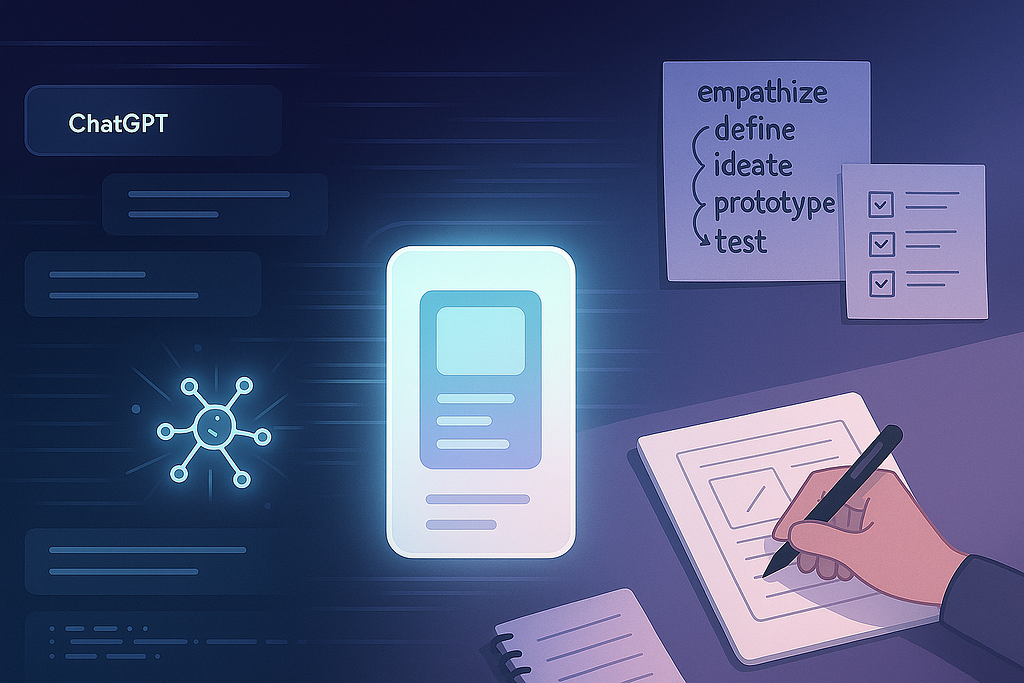
Why the designer mindset matters more than ever, even when AI writes the code.
There’s a common myth floating around these days: that working with AI is just about crafting the right prompt. Write a clever line, press enter, and voilà — magic happens.
But anyone who’s actually built a product — especially as a designer — knows that the real work starts long before that prompt. Before a line of code is generated, before Figma files are opened, and long before anything gets shipped. It starts with a problem. A user. A context. And a sense of what good looks like.
When I set out to build and ship my first Shopify app in a single weekend, I didn’t intend to prove a point. I was just trying to solve a problem I knew merchants were facing. But in doing so, with only AI tools like ChatGPT and Cursor as teammates, I ended up rediscovering something familiar: that what makes a product truly work — understanding people, their needs, and designing around that — still comes from design thinking.
The Same Process — Just Faster
The classic design thinking loop — empathize, define, ideate, prototype, test — hasn’t gone anywhere. But what AI tools offer is acceleration.
In this project, the first hours weren’t spent building, but understanding. I explained the problem to ChatGPT like I would to a colleague. I asked it to take on different roles: product manager, Shopify expert, backend developer. I questioned constraints, validated assumptions, and explored what-if paths.
Each conversation felt like a mini ideation sprint. With every response, I got clearer on what mattered and what didn’t. It was collaborative, but not in the traditional sense. I was still steering. The AI just made the turns quicker.
From Designer to Decision-Maker
One of the most profound shifts came in how I worked. Instead of generating wireframes for someone else to implement, I found myself making product decisions directly.
Which feature was essential? What could wait? How would it feel to a first-time merchant installing the app? Those weren’t questions I was leaving to a PM or dev — they were mine to answer.
The AI helped with execution, sure. But it needed me to direct it. My value wasn’t in pixels or prototypes. It was in framing the problem and setting the bar for quality.
Design, in this context, wasn’t decoration. It was direction.
Why Inputs Are Everything
A vague prompt results in vague output. That’s not a new idea — it’s just more obvious now.
In the AI loop, your ability to articulate matters more than ever. Clarity becomes the multiplier. If you can describe the edge case, imagine the user’s moment of friction, or sketch the flow in words, you’re already ahead.
This is where the designer’s mind shines. We’re trained to think in systems, to connect dots, and to speak the language of constraints. That’s what makes AI powerful — not the code it generates, but the quality of thinking that goes into the request.
What the AI Couldn’t Do
There were plenty of things the AI couldn’t (or wouldn’t) do:
It didn’t notice the micro-interaction delay that could erode user trust. It didn’t argue with itself about tradeoffs. It didn’t know why the opt-in needed to feel effortless to encourage conversions.
It didn’t feel the pain of a poor UX — I did. That’s what kept me refining.
Where We’re Going
This isn’t about replacing developers or designers. It’s about giving individuals the ability to prototype and ship more than ever before.
AI takes care of the repetitive. The boilerplate. The setup.
Designers? We bring the spark. The insight. The taste.
Soon, it won’t be unusual for a solo designer to launch a tool, test a feature in production, or lead full-stack experiments. And as that happens, our focus will shift from execution to intention — what are we choosing to build, and why?
The Designer’s New Role
We’re entering a world where designers shape behaviours, orchestrate flows, and define success — not just through pixels, but through problems solved.
AI doesn’t take away our need to understand people. If anything, it makes that understanding more valuable.
Because when everyone can build, the builders who ask better questions — those are the ones who will stand out.
Design Thinking in the Age of AI: The Process Is the Product was originally published in UX Planet on Medium, where people are continuing the conversation by highlighting and responding to this story.

